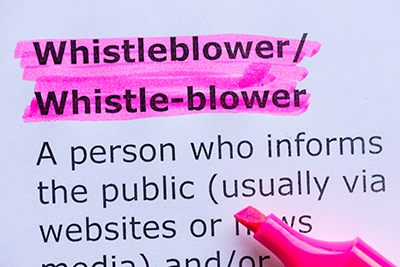Whistleblower charges alleging workplace safety retaliation have surged dramatically during COVID-19. Approximately 30 percent more charges have been filed with the Occupational Safety and Health Administration (OSHA) over the same period last year, according to a recent audit from the U.S. Department of Labor (DOL) Office of Inspector General.

The charge rate in the states and territories with state OSHA-certified plans—about half the country—is believed to have increased at a similar pace. The volume of safety-related retaliation charges is likely to persist (and potentially increase) as employers and governments continue to grapple with stay-at-home and return-to-work orders and protocols and the approaching flu season and as vaccine candidates draw closer to approval and distribution. With that in mind, here are concrete steps you can take to avoid adverse whistleblower complaint findings.
Types of Whistleblower/Retaliation Claims Under OSHA
There are two varieties of whistleblower claims under the Occupational Safety and Health (OSH) Act. The first resembles equal employment opportunity-related retaliation charges many employers may be familiar with and requires the following elements:
- The employee participated in activity protected by the OSH Act;
- The employer subjected the individual to an adverse employment action; and
- A causal connection exists between the protected activity and the adverse action.
Protected activities include complaining about workplace safety conditions to an employer, filing a safety complaint with OSHA, or cooperating in an agency investigation.
Adverse actions include any action that might dissuade a reasonable worker from engaging in OSH Act-protected activity. They include termination, demotion, and suspension. Some courts have found they also cover other, less obvious actions, such as an unfavorable job reference, a lateral transfer, or a change in work schedule.
The second kind of whistleblower claim is more uniquely related to workplace safety. It can occur when an employee refuses to work because she reasonably believes engaging in the required activity presents “a real danger of death or serious injury.” Employees alleging this kind of whistleblower complaint face a higher burden and must prove they:
- Had a reasonable apprehension of death or serious injury;
- Refused to work in good faith;
- Had no reasonable alternative besides refusing to work (e.g., they can’t do the task in a safe way, such as through remote work);
- Had insufficient time to eliminate the condition through regular statutory enforcement channels (e.g., by contacting OSHA); and
- When possible, sought a correction from their employer but were unable to obtain it.
Damages and Reinstatement Under OSHA Retaliation Claims
A successful whistleblower retaliation claim can result in back wages, the employee’s reinstatement, reimbursement for attorneys’ and expert witness fees, and other remedies required by the court or agency.
If OSHA determines a complaint has merit but a voluntary settlement can’t be reached, the DOL’s Office of the Solicitor of Labor may choose to litigate the case on the whistleblower’s behalf in federal district court. If OSHA determines the complaint lacks merit, it will dismiss the case. The employee may appeal the dismissal within the agency by filing a request for review within 15 days of receiving the adverse decision.
If OSHA determines the dismissal was improper, it can reopen the case. If the agency decides the dismissal was proper, the ruling represents the secretary of labor’s final determination. Employees aren’t entitled to file their own civil lawsuit under the federal scheme (although private claims in which the agency declines further action are possible in some state-plan jurisdictions).
Best Practices
Many employers that have little or no experience with responding to employees’ workplace safety concerns or dealing with OSHA inspections are at significant risk for the issues to arise because of heightened worker anxiety over COVID-19. The pandemic has rendered all workplaces with onsite employees (or customers) potentially hazardous. Accordingly, you can and should take steps to reduce the likelihood of exposure to successful whistleblower claims:
Supervisor training. Educate your HR staff, safety department, managers, and supervisors that safety complaints are protected activity. For previously low-hazard work environments, the risk may not be understood or obvious to all team members.
Government protocols. Ensure your COVID-19 policies and protocols meet applicable U.S. Centers for Disease Control and Prevention (CDC), state, and local orders and guidelines. The guidance changes frequently, but state and county public health departments are typically a good source of information. Lacking those kinds of policies and procedures may lend legitimacy to a coronavirus-related whistleblower charge.
Personnel policies. Ensure your COVID-19 policies and protocols are being followed in practice. Having written programs that aren’t executed in practice won’t meet current coronavirus obligations and may lend legitimacy to a whistleblower charge.
Employer responses. If an employee refuses to work because of safety fears, listen to the basis for the concern, and consider whether it’s reasonable in light of current public health authority guidelines (for example, regardless of your company’s view on mask wearing, if current guidelines direct or encourage doing so at work and coworkers are working in close proximity without masks, the complaining individual’s worry may be sufficient to support a claim). Here are some other helpful responses:
- If the job can be done by another means (e.g., teleworking), consider the option.
- If any safety complaints appear valid, address them, and document the reasons for your decisions.
- If an employee refuses to work for safety reasons, carefully document your communications with her. Any adverse actions should be well-documented and justified by legitimate business reasons.
OSHA inspections. If an OSHA or a state-plan compliance enforcement officer inspects the workplace, you shouldn’t try to determine who filed the complaint. If you know (or believe you know) who leveled the charge, you should take extra caution to avoid the appearance of retaliating against the individual.
Joseph P. Hoag and Nick Wegley are attorneys with Davis Wright Tremaine LLP. You can reach them at josephhoag@dwt.com or nickwegley@dwt.com.
